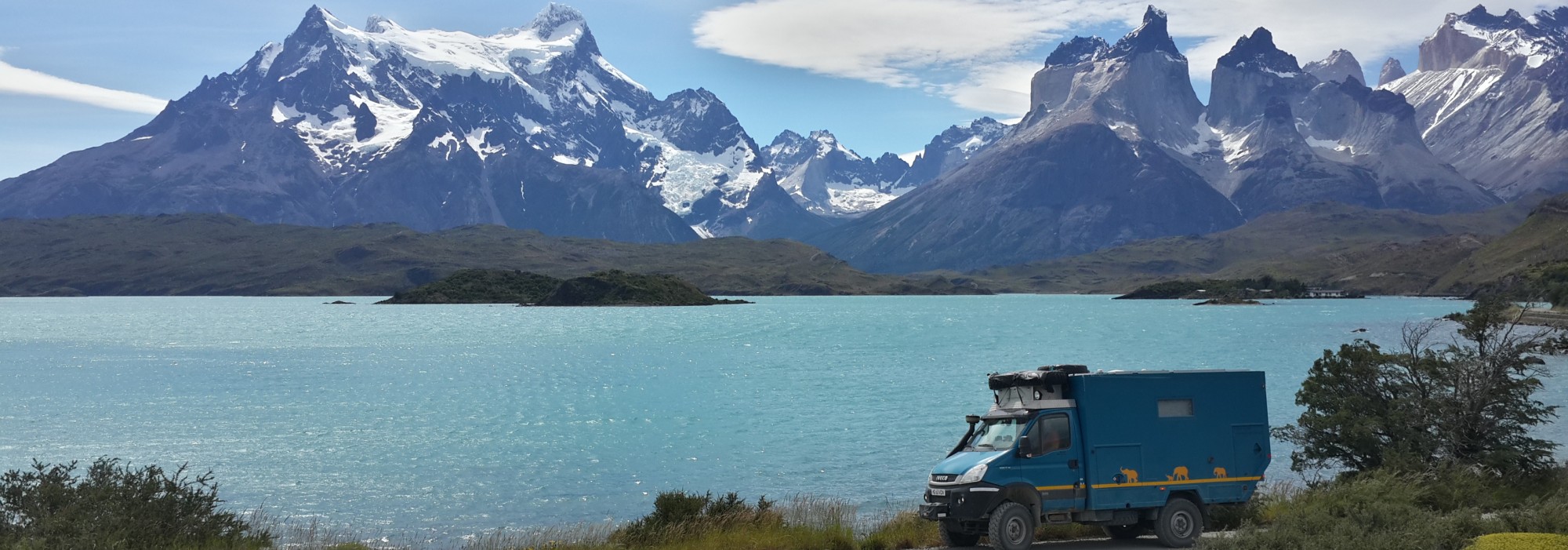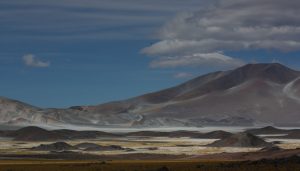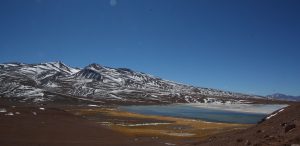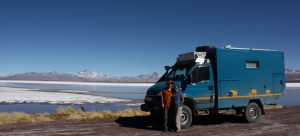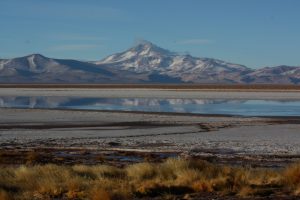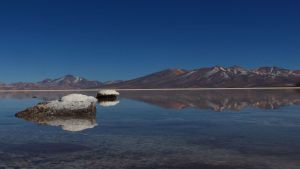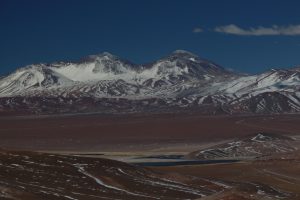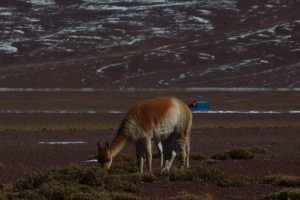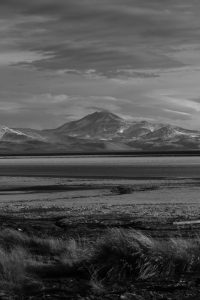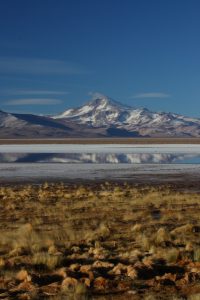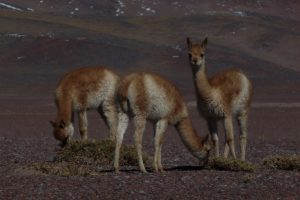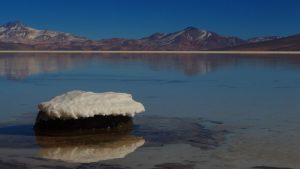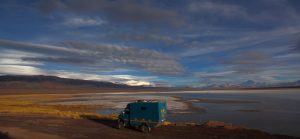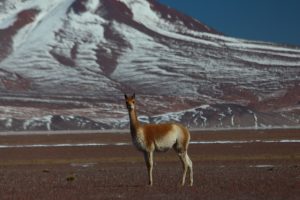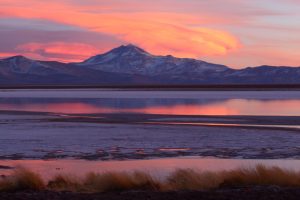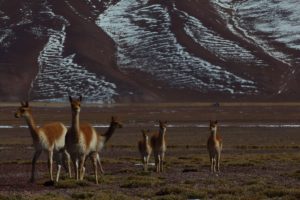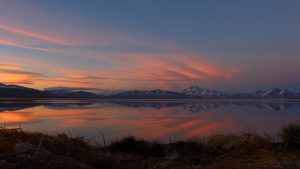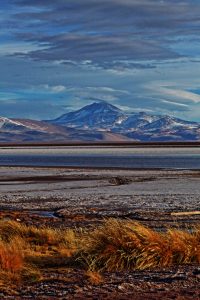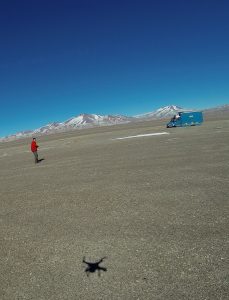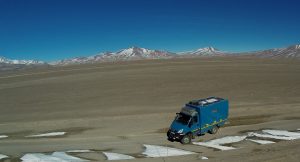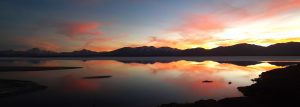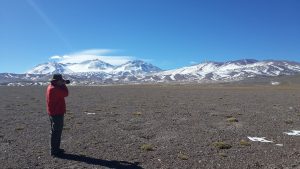Pisco brandy and astronomy are two of the things for which Chile’s Elqui Valley is famous. We’re rather fascinated by the stars and planets, and we also aren’t averse to the odd drop of brandy and wine tasting, so the Valley holds some interest for us. After that we need to dodge the snow and find an ‘all-year’ Pass to cross the Andes, but first we’re heading to the coastal town of Valparaiso.

‘Heads’ you win, ‘Tails’ you lose!
Readers of the last Cuthbert blog may recall that before leaving Santiago, we tossed a coin to decide whether to route north via (heads) the Argentinian, or (tails) the Chilean side of the Andes. In this case, ‘tails’ won the toss, so we’re staying in Chile for now. Valparaiso has been described as: ‘a ramshackle San Franciso-style city, chaotically built on several steep hills, with the best street-art in South America’, so we were intrigued to see it for ourselves (click here to see route map)
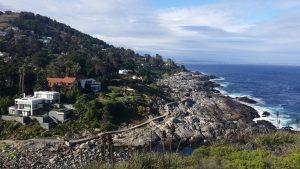
Zapallar – nice villas!
It’s only 100km or so from Santiago down to the coast, but when we got to Valparaiso we found ‘Grim’ (yes, with a capital G!). It’s strange how some places are just so goddam attractive that they can draw you in for a few days under any conditions. Other less fortunate locations need the benefit of blue sky and sunshine to give them any appeal whatsoever. Poor Valparaiso falls into the latter of these two categories. On our arrival it was overcast and drizzly, the streets are narrow and the traffic was horrendous. There seemed to be large amounts of litter everywhere and the people (perhaps not surprisingly) looked miserable as sin, going about their business with frowns and stooped shoulders. You may by now be receiving the (well guided) impression that we didn’t really ‘feel the love’ for Valparaiso. After driving around for over an hour and finding nowhere to park Cuthbert, we decided to head out of town. Perhaps we didn’t give the place a fair chance. Maybe we owe Valparaisans an apology here, but for us it just wasn’t to be and we didn’t go back. Oh well, you win some, you lose some!
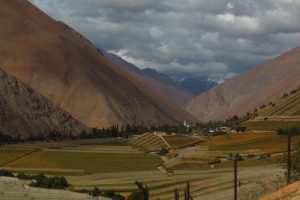
Elqui Wine valleys
By contrast, the coast to the north of Valparaiso is much more attractive. A string of great beaches show-case a variety of development along them. Some are spilling over with high-rise holiday-apartment blocks, while others are very chilled-out ‘beach-shack’ kind of places. Our favourite was swanky Zapallar, a low-key development area with beautiful designer mansion-villas and manicured gardens sweeping the hill-sides around the beaches and rocky coves. Zapallar isn’t the kind of neighbourhood which appreciates travellers parking-up in camper-trucks on their doorstep (and frankly, neither would we if we lived in one of these places J), so we didn’t stay there overnight. But when we win the lottery and are bored of travelling, we could happily retire here (note to self: must buy lottery ticket!) 🙂
Pisco Elqui
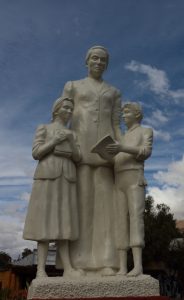
Gabriela – a happy soul!
Next we’re back on the Pan-American super-highway and heading north towards the attractive Elqui Valley and the town of Vicuña. Lonely Planet lists the area as one of their Top 20 destinations in Chile. So what gives? Well… this very scenic area is ‘famous’ (and we use that term in the loosest possible sense) for grape growing for pisco production, world-class space observatories, solar cooking, and a new-age cosmic-energy community no less. And Oh… almost forgot… it’s also famous for Gabriela Mistral. You’ve heard of her, right? No? Neither had we. She’s a Chilean national icon and winner of the Nobel Prize for Literature. They’re rather proud of the fact that she grew-up around here. ‘Nuff said about that. But perhaps a little more explanation required about this ‘pisco’ stuff, maybe?
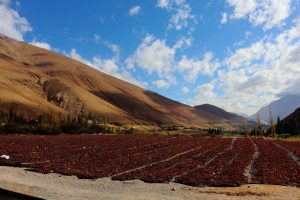
Pisco grape drying
Pisco is a potent grape-brandy widely drunk in Chile both neat and in the ubiquitous Pisco Sour cocktail, however the drink is not without controversy. For years it has been the subject of an international legal battle between Peru and Chile (each claiming to be the originator of the drink and it to be their national tipple). Chile has changed the name of one of its small towns to ‘Pisco Elqui’ to try to reinforce its claim, and although Peru has won an interim stage of the case before the Word Intellectual Property Organisation, the pisco legal battle is far from over yet! Watch that pisco space!
Having heard about the legal wrangling and in the interests of thorough research, it was incumbent on us to attend a pisqueria (a pisco distillery) to see what all the fuss was about. We had an interesting tour of the pisco making process and of course the complimentary tasting of samples in the sales room at the end of the tour. It would have been churlish to leave without a bottle, so we now have a litre of their finest 40% proof pisco to consume over the next few… er… weeks.
Another attraction of the Valley is the ‘cosmic-energy thing’. A certain section of society is attracted to the area for the ‘supernatural aura’ and ‘cosmic vibes’ of Cochiquaz. There are two factors to consider about this village: (i) it hosts a community of new-age cosmic worshippers; and (ii) it has a higher than average number of reported UFO sightings. A sceptic may conclude that these two factors are linked; we couldn’t possibly comment 🙂
Sun and stars
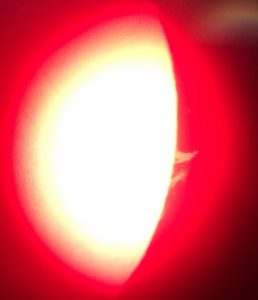
Solar flare – through the telescope
Regular Cuthbert readers may recall that a few weeks ago we enjoyed visiting the space research centre in Malargϋe, Argentina. Well the Elqui Valley is sort of Chile’s equivalent of this; the skies here are so clear as to attract several internationally sponsored space research observatories. And there are other astro-type attractions too…
First, we went to a small sun observatory run by a German chap from his home in Vicuña. We had a fascinating morning studying the sun through a special solar telescope and learning about the solar activity. We saw a black-spot on the sun’s surface and watched solar flares building up before our very eyes (well actually, if we’re being pedantic, speed of light and all that… they happened around 8 minutes before we saw them. Whatever…!). Apparently there aren’t many of these solar telescopes in the world, so we were really chuffed to have a go with one.
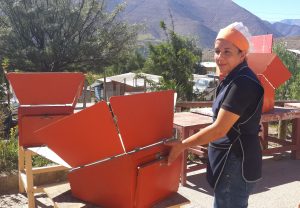
Solar cooking
Continuing with the ‘sun’ theme for the day, we had lunch in one of Vicuña’s innovative solar-restaurants. Due to a deficit of firewood in the Elqui Valley, the women folk have learned to cook without making fire (and no… it’s not a microwave 🙂 )! Their ovens consist of a box with a glass top-lid, and a large shiny silver reflective collar. The boxes are pointed at the sun so that the rays focus through the glass lid onto the food inside. Bread is baked and casseroles are left in there for hours, resulting in tastily slow-cooked meats. It was a lovely lunch and it was fun, but to be honest, it did all look a bit of a faff. In addition to the obvious need for sunshine, we can’t see the busy European working mum fitting this into her schedule anytime soon!
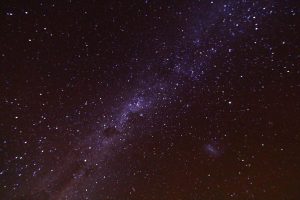
Milky Way – looked pretty good before we got the telescope!
Our ‘sun and stars’ stay in the Elqui Valley was rounded off with a visit to one of the space observatories to meet with a French and a Chilean astronomer and learn about their work. High on a hill-top outside the town, the sky was crystal clear and as the sun set, the stars and the Milky Way began to appear with amazing clarity. Even with the naked eye it was an impressive sight, but with the power of the ‘super-dooper’ telescope (probably not the correct technical term, but you get the idea) we saw soooo much more. A detailed look at Mars and Jupiter was fascinating, but we also witnessed some awesome events in space: the formation of an embryonic new star in a distant galaxy which was actually happening some 150,000 years ago; an old star in its final phase of exploding and expiring; and another distant star around 7,300 light years away, venting gasses in the style of Mickey Mouse ears! In another view of a far-off galaxy, we saw 5,000,000 (yes, five million!) stars in a single view. It seems unlikely that anyone has actually sat down to count them individually, but we are reliably assured that the figure has been scientifically guesstimated by some smarty-pants who knows about these things. Eventually at around 23:00 hrs the moon came up brightly and cruelly spoiled our fun, but it was a truly fascinating evening – well worth the trip.
Pass or Not to Pass?
Had we arrived in the Elqui Valley a few weeks previously, we would from Vicuña have continued down the valley and over the reportedly beautiful Paso Agua Negra to Argentina. But this road closes in March for the winter and we have to push on another 500 km further north to the next ‘year-round’ open pass. So we’re back on the Pan-Am highway northbound again, with a full day’s drive to the town of Copiapó. This is the southerly end of the Atacama Desert and a huge mining area which spans from the desert up into the mountains. We drove out into the Atacama dunes for a night-stop (happy memories of our days desert camping in the Middle East) and went past the mine where the Chilean miners were famously stranded and rescued in 2010.
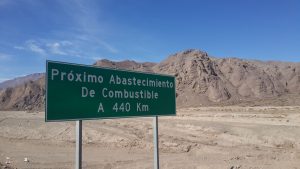
Next fuel – 440km!
During a short stop in the town of Copiapó we discover that the reportedly excellent mineralogical/ geological museum is closed ‘until further notice’ 🙁 Oh well! It’s now time to head east into the Andes again for the year-round border-post to Argentina. At 4,725 metres (15,500 ft) a.s.l. the San Francisco Pass will be the highest that Cuthbert has ever been and we are interested to see how he performs at that altitude. In fact it’s also the first time that we have been at that altitude for any length of time, so we will see how we fare too. As we drive out of town a sign warns ‘Next fuel – 440km’, good job we filled Cuthbert’s long-range tank. We have looked at the route on the map… it’s a looong way over them there hills!
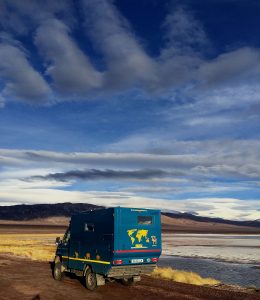 Eventually at around 4,000 metres a.s.l. we rounded a corner and our jaws dropped open… before us was the Chilean border post sitting by the huge Maricunga salt-lake, in the bottom of a huge shallow valley surrounded by snow-capped mountains. This ranks with the Sani Pass (South Africa to Lesotho) as one of the most beautiful border posts that we have crossed in our travels so far. After manually closing our dropped jaws, we continued down into the valley to exit the border.
Eventually at around 4,000 metres a.s.l. we rounded a corner and our jaws dropped open… before us was the Chilean border post sitting by the huge Maricunga salt-lake, in the bottom of a huge shallow valley surrounded by snow-capped mountains. This ranks with the Sani Pass (South Africa to Lesotho) as one of the most beautiful border posts that we have crossed in our travels so far. After manually closing our dropped jaws, we continued down into the valley to exit the border.
Remember we mentioned above that this is advertised as a ‘year-round’ border crossing…? Well the person who announced this should now be finding an extinguisher for their proverbial ‘pants on fire’! At the border-post a friendly police chap explains that due to snow some 40 km further towards the Pass, the border is not open today. They are apparently working hard to clear the snow and the Pass may open tomorrow. It is already late Thursday afternoon, so parking-up for the night on the lakeshore with stunning views of the surrounding mountains would not be any great hardship. Next morning we are told that it will not open until Saturday or Sunday, but there is some amazing countryside to explore with glorious sunshine and clear blue skies, so we are happy to hang around and explore the area for a couple of days. At around 13,000ft the thin air makes it a challenge for us to undertake any steep walks in the mountains, but we visited the nearby Nevada Tres Cruces National Park and found some gentle walks across the flat plains. We loved sitting in the sunshine on the high Andes plains, watching a small herd of vicuñas (the llama’s smaller and cuter relative) which wandered up to about 10 metres from us.
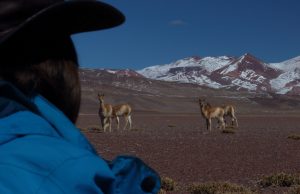
Vicuna watching
When we return to the border post we’re told that the Pass will not open until Monday morning! We contemplate returning back down to the coast and heading north to the next open border crossing, but it would be a loooong detour of several hundred miles and we are still enjoying ourselves up here. The puzzling part is how it can take them three days to clear some snow. Either that must have been some huge snow-dump, or the ‘man with shovel’ is taking his time! On Sunday we asked the policeman how the snow clearing is going, “Oh, that was all done on Friday” he replied. “Now we’re just waiting for the Immigration Officer to turn up! Should be here by 09.00 hrs Monday” :-0
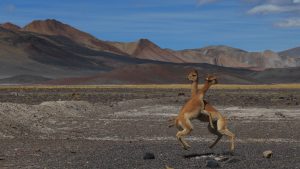
Vicunas – having a go!
So the advertised ‘year-round’ border closes not only for snow clearing, but also when the officers can’t be bothered to turn up! On Monday morning we eventually get back on the road to Argentina. It’s 100km from the border-post to the actual border line, then another 200km to the first town in Argentina. Incidentally, as we went over the Pass we saw that the area of cleared snow was no more than a small snow-drift covering a mere 10-15 metres section of road!!! Anyway… we didn’t mind too much. We’re in no hurry and have enjoyed exploring the beautiful area. And it has been a useful trial for both Cuthbert and us to see how we manage at great altitude. We have all been fine over three days at 3,700 metres in the valley and the Pass at over 4,700 metres. Cuthbert proved to be a little under-powered when pulling away, but he otherwise worked well (the techie-gurus amongst you may be inclined to click here study the critical detail and store the data for future reference:-) ). Like Cuthbert, we also had no altitude sickness, so this bodes well for even greater altitudes in Bolivia and Peru when we reach there later in the year.

After a stunning drive over the San Francisco Pass and past the highest volcano in the world, Ojos del Salado, we’re now back in Argentina and looking forward to exploring the far north-west of the country. We don’t have an exact route planned, but this could well be our last foray into Argentina as we move-on north. Better make the most of those juicy Argentinian beef steaks while we can then! 🙂
Link to next blog: North-west Argentina Link to full South America Blog
Chile Andes Gallery
- DCIM100GOPRO
- DCIM100GOPRO
